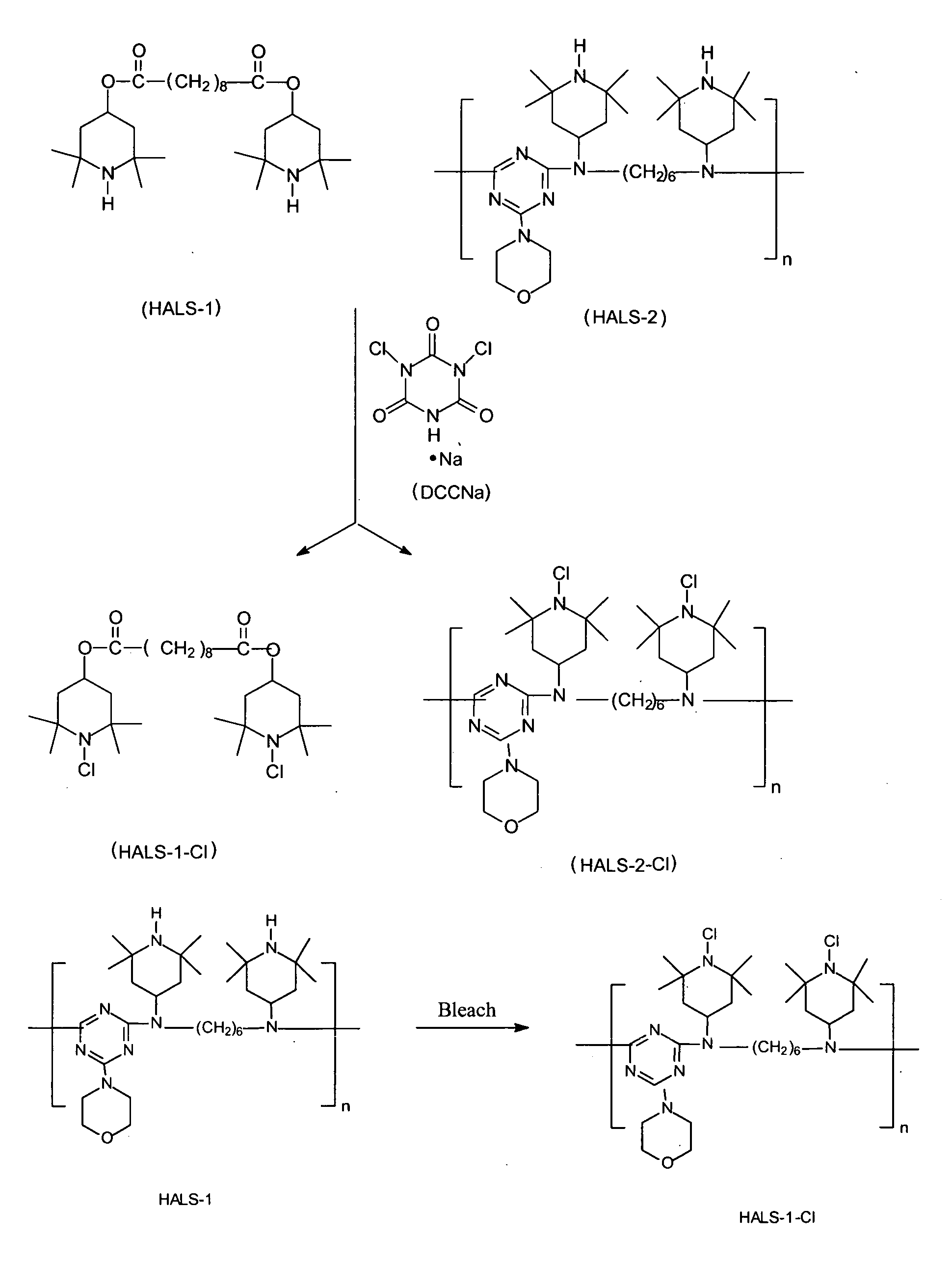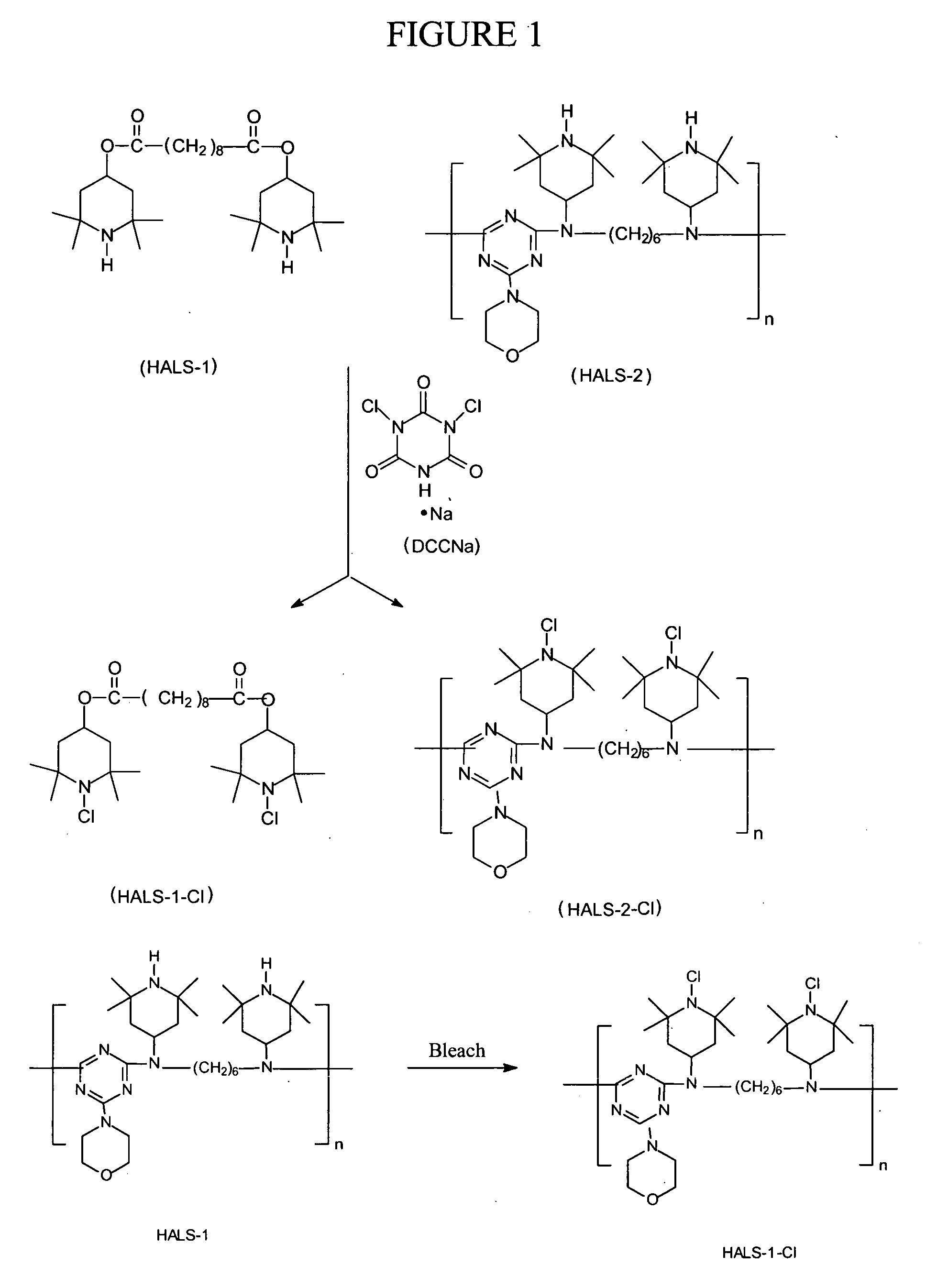Method for transformation of conventional and commercially important polymers into durable and rechargeable antimicrobial polymeric materials
a polymer material, antimicrobial technology, applied in the field of antimicrobials, can solve the problems of increasing the cost of antimicrobial additives, etc., to achieve the effect of simple, practical, flexible and cost-effectiv
- Summary
- Abstract
- Description
- Claims
- Application Information
AI Technical Summary
Benefits of technology
Problems solved by technology
Method used
Image
Examples
example 1
[0041] SHC-1. A solution of sodium dichloroisocyanurate (DCCANa, about 8.8 grams, about 0.04 mol) in water (about 40 ml) was added to a solution of about 9.6 grams (about 0.04 mol) SHA-1 in toluene (about 20 ml). The mixture was vigorously shaken for about 10 minutes. Toluene (about 10 ml) was then added. The precipitated cyanuric acid was filtered off. The organic layer was separated from water. After the evaporation of toluene, the solid was collected and recrystallized from petroleum ether to produce a yield of 77%, a melting.temperature of 83° C. and an active chlorine content of 12.5%.
[0042]FIG. 1 illustrates one of the synthesis methods associated with the present invention. The present invention provides that Bis(2,2,6,6-tetramethyl-4-piperidyl) sebacate (HALS-1) is be treated with sodium dichloroisocyanurate (DCCANa) to produce Bis(N-chloro-2,2,6,6-tetramethyl-4-piperidyl)sebacate (HALS-1-Cl).
example 2
[0043] SHC-2. A solution of DCCANa (about 8.8 grams, 0.04 mol) in water (about 40 ml) was added to a solution of about 5.95 g (about 0.04 mol) SHA-2 in toluene (about 20 ml). The mixture was vigorously shaken for about 20 minutes. Toluene (about 10 ml) was then added. The precipitated cyanuric acid was filtered off. The organic layer was separated from water and then dried under anhydrous CaCl2. About 50 ml of methanol was added; the precipitates were collected by filtration, washed with methanol, air-dried over night and stored in a desiccator at room temperature for about 72 hours to reach constant weight to produce a yield of about 75%, a melting point of about 280° C. (dec.) and an active chlorine content of about 7.96%.
example 3
[0044] SHC-3. A solution of DCCANa (about 8.8 grams, 0.04 mol) in water (about 40 ml) was added to a solution of about 8.2 grams (about 0.04 mol) SHA-3 in toluene (about 20 ml). The mixture was vigorously shaken for about 10 minutes. Toluene (about 10 ml) was then added. The precipitated cyanuric acid was filtered off. The organic layer was separated from water. After the evaporation of toluene, the solid was collected and recrystallized from petroleum ether to produce a yield of about 79%, a melting point of about 32° C. and an active chlorine content of about 7.86%.
PUM
| Property | Measurement | Unit |
|---|---|---|
| temperature | aaaaa | aaaaa |
| melting point | aaaaa | aaaaa |
| melting point | aaaaa | aaaaa |
Abstract
Description
Claims
Application Information
 Login to View More
Login to View More - R&D
- Intellectual Property
- Life Sciences
- Materials
- Tech Scout
- Unparalleled Data Quality
- Higher Quality Content
- 60% Fewer Hallucinations
Browse by: Latest US Patents, China's latest patents, Technical Efficacy Thesaurus, Application Domain, Technology Topic, Popular Technical Reports.
© 2025 PatSnap. All rights reserved.Legal|Privacy policy|Modern Slavery Act Transparency Statement|Sitemap|About US| Contact US: help@patsnap.com



